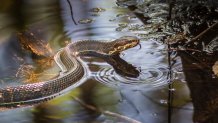Some 160,000 drivers motor through the Caldecott Tunnel each day. But few are probably aware of the wild critters making their own travels somewhere above the cars.
Ecologists with the East Bay Parks District themselves weren’t exactly sure how many wild animals were using the forest corridor above the tunnels — a 300-acre parcel of land purchased by the district 20 years ago to preserve as open space.
“Right up until several months ago, it wasn’t 100 percent clear whether it was or not an important corridor,” said Steve Bobzien, an ecologist with the park district. “We’ve been documenting over the years animals being killed on Highway 24.”
Back in December, the park district installed a pair of motion-activated wildlife cameras on a moss-covered tree on the hilltop, about a hundred yards above the westbound lane of traffic on the Caldecott corridor. Bobzien hoped to determine whether animals were using the crossing, which links nearby Sibley and Tilden Parks.

Bobzien wasn’t sure what, if anything, the cameras would capture. But when the first images from the cameras were loaded into a laptop computer, his eyes lit up as a variety of critter snapshots filled the screen.
“The first images we saw — we had coyotes and bobcats,” Bobzien said. “The very first check we had a mountain lion.”
Local
Bobzien said the cameras photographed raccoons, deer, possums, skunks, bobcats, foxes and coyotes. But the real coup was a young male mountain lion which the cameras captured returning in January and then again in February.
“It’s like opening a Christmas gift every time we come and check the images,” Bobzien said. “Because no matter how often you do it, it’s really exciting.”
Wildlife Cameras Above the Caldecott Tunnel
The cameras take color photos during the day and infrared at night —producing images that look something like wildlife suspect photos. As an unintended feature of the motion-detection cameras, they also photograph the feet of people using the hiking trails. Bobzien said the human photos are quickly deleted.
“That’s what’s amazing,” grinned Bobzien gesturing toward one of the cameras, “what we have people do in front of these.”
Bobzien said the results of the cameras have confirmed the wooded area as a vital wildlife corridor which animals utilize, sparing themselves the dire consequences of attempting to cross the treacherous highway below. The images also reveal that animals tend to avoid the trails during the daytime when humans are on them.
“It’s really pretty clear that they’re doing an amazing job of avoiding people,” Bobzien said, sitting at a wooded picnic table hunched over a laptop, scanning a new batch of wildlife photos.

The park district has experimented with wildlife cameras, including some that capture video, in nearby parks including Sibley. Bobzien played a crystal clear color video of a mountain lion casually watching a possum scamper by, before strolling off in another direction.
“We share these hills with all the wildlife,” said park ecologist Courtney Wilson. ”It’s good to see that they’re out there.”
Ecologists are using the photos in an informal study — comparing the different species, their activities and movements over time. The images will give the park a more complete snapshot of life in the hilltop’s wooded habitat just a stone’s throw from the bustling highway.
On a recent day, Bobzien walked the muddy trail to the hilltop to clean the camera lenses and to remove the data cards. As he loaded the images into his computer, he let out an incredulous laugh as he spied yet another picture of the mountain lion among the batch of new pictures.
“We always tend to see something really remarkable,” Bobzien said. “The thrill never leaves us.”



